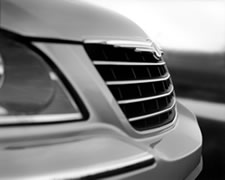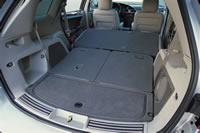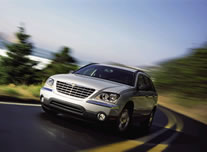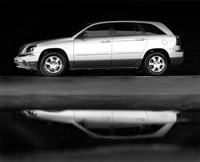 Shopping
for a new family car, minivan or sport utility vehicle? Shopping
for a new family car, minivan or sport utility vehicle?
Take
a look at today's station wagon-styled vehicles, too. The newest of this class,
such as the 2004 Chrysler Pacifica, do a good job of melding car, minivan and
SUV traits.
The
Pacifica, which Chrysler officials prefer to label a "sports tourer,"
rides higher than a traditional, car-based station wagon would. And while the
Pacifica has the same number of seats — six — that you'd find in old-time station
wagons, the seats here are arranged, minivan-like, in three rows — two to each
row.
Best
of all, despite being nearly as long in overall length as Chrysler's Town &
Country minivan, the Pacifica doesn't drive like a large vehicle and doesn't have
a minivan shape or stodgy minivan image.Yes,
headroom in most seats is less than in a minivan, since the Pacifica is 2.4 inches
shorter in height than a Town & Country. And cargo space is less.
 But
the Pacifica still has a commendable 43.6 cubic feet of storage space behind the
second row seats, and the Pacifica's third-row seats fold flat into the floor
with one-hand operation, so there's no lugging the seats outside and leaving them
behind. The Pacifica is offered with power liftgate at the back, the same feature that Chrysler pioneered on its minivans. But
the Pacifica still has a commendable 43.6 cubic feet of storage space behind the
second row seats, and the Pacifica's third-row seats fold flat into the floor
with one-hand operation, so there's no lugging the seats outside and leaving them
behind. The Pacifica is offered with power liftgate at the back, the same feature that Chrysler pioneered on its minivans.
Initial pricing isn't family-friendly. At introduction, a base 2004 Pacifica with
front-wheel drive carried a starting manufacturer's suggested retail price, including
destination charge, of more than $31,000. Chrysler
officials promised that before summer 2003 is out, a Pacifica with an under-$30,000
price tag would be available. My test Pacifica, an uplevel all-wheel-drive
model with options like power sunroof and leather seats, topped out at nearly
$36,000 and showed just how pricey a Pacifica can become.
| Pacifica
Wins Five-Star Crash Ratings | | The
Pacifica won five-star ratings in both front and side impact crash tests conducted
by the National Highway Traffic Safety Administration. [more] |
One
of the additional-cost options is a noteworthy navigation system. While lots of
vehicles have nav systems now, the Pacifica becomes the first vehicle to incorporate
its nav display in the center of the speedometer, so it's not in a separate display
screen somewhere in the dashboard between the driver and front passenger.
Chrysler
officials said consolidating the nav system into the instrument panel means it
should be easier for a driver to keep eyes on the road.I found it prevents
that Pacifica's front-seat passenger from helping with navigation duties, because
when I peeked over at the nav system from the passenger seat, the scrolling up
of the map among the gauges made me carsick.
 All
Pacificas are powered by a 250-horsepower, 3.5-liter, single overhead cam V6 that's
also used in the Chrysler 300M large sedan. Torque is 250 lb.-ft. at 3,950 rpm,
and the Pacifica uses the 300M's four-speed automatic transmission with shift-it-yourself
AutoStick function. But the lengthy Pacifica — it's 16.5 feet long — weighs
some 900 pounds more than the 300M. All
Pacificas are powered by a 250-horsepower, 3.5-liter, single overhead cam V6 that's
also used in the Chrysler 300M large sedan. Torque is 250 lb.-ft. at 3,950 rpm,
and the Pacifica uses the 300M's four-speed automatic transmission with shift-it-yourself
AutoStick function. But the lengthy Pacifica — it's 16.5 feet long — weighs
some 900 pounds more than the 300M.
So while acceleration in the front- and all-wheel-drive Pacificas is pleasant and acceptable for many mainstream drivers, there's no instantaneous power surge for sporty-minded drivers. And the estimated fuel economy of the all-wheel-drive model is more SUV-like than car-like. In fact, the 17/22 mpg rating matches that of the Honda Pilot sport utility vehicle.
I heard the Pacifica's engine on acceleration only and scarcely heard nearby cars and trucks because the Pacifica's interior is impressively quiet. There wasn't noticeable wind noise, either, though the tester did not have a roof rack on it.
Handling in the all-wheel-drive model was commendable, too, with the Pacifica's body motions nicely managed and the vehicle feeling as if it's much shorter and more nimble than expected. The ride doesn't come across as firm, nor is it truckish or floaty.
Note that self-leveling shock absorbers are standard at the rear. Tires are 17-inchers and help give the Pacifica that substantial and stable-looking appearance.
 Rack-and-pinion steering has decent on-center feel, and most of the time, even the all-wheel-drive Pacifica travels with power going primarily to the front wheels. When any slippage is detected, power is automatically routed to the rear to help out, and a driver might not notice that the system has gone into effect. Rack-and-pinion steering has decent on-center feel, and most of the time, even the all-wheel-drive Pacifica travels with power going primarily to the front wheels. When any slippage is detected, power is automatically routed to the rear to help out, and a driver might not notice that the system has gone into effect.
With the exception of the stereo faceplate and controls, which are the typical Chrysler shape and look of recent years, the interior of the Pacifica has a European sense. The front four bucket seats have sculpted backs and looked ritzy in leather. As you rest onto them, you sink in just a bit.
At 5 feet 4, I sort of just turned and sat onto the seats in the Pacifica, not having to pull myself up into the vehicle. But I did have to make sure I ducked my head to keep from hitting the lower roof edge. The Pacifica's luminescent gauges are Lexus-like, with bright red needles seeming to float, rather than connect mechanically, to the gauges.
The faux wood trim on the dashboard looks good; it's better than the cheap-looking, satin-finish silver trim that's at the top of the doors, around the door handles inside.
 Note that shoulder room is less than in a Town & Country minivan in all three rows of the Pacifica's seats. But legroom in the first and second rows of the Pacifica is better than it is in the comparable rows of the minivan. The third-row seat's 29.9 inches of legroom is 7.4 inches less than what's in the Town & Country, and my hair brushed the ceiling as I sat back there. Note that shoulder room is less than in a Town & Country minivan in all three rows of the Pacifica's seats. But legroom in the first and second rows of the Pacifica is better than it is in the comparable rows of the minivan. The third-row seat's 29.9 inches of legroom is 7.4 inches less than what's in the Town & Country, and my hair brushed the ceiling as I sat back there.
I appreciated that just a couple quick lifts of levers on the second-row seats get those seats out of the way for access to the Pacifica's third row. But I wished the Pacifica's four front-hinged doors opened wider.
Watch as you back up in the Pacifica. The high back window may not afford a good view of low items. Chrysler officials said they planned to add a rear park assist feature in the future.
Click here for more information on the Chrysler Pacifica.
For the Chrysler 2004 Model Guide : Click Here
|